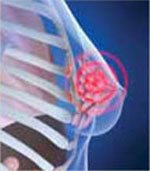
A SWOLLEN, TENDER AREA DEVELOPED on a mother’s right breast 3 weeks after giving birth. She called her ObGyn to report that pus was oozing from the nipple. He prescribed an antibiotic for what he presumed to be a clogged milk duct, and told her to continue to breastfeed. The infection worsened, until milk ceased to flow and the breast was red, painful, and warm.
At an office visit 2 weeks after the phone call, the ObGyn prescribed a new antibiotic, and told the mother to let the right breast milk dry up. Within 24 hours, pus breached the skin several centimeters above the nipple. The patient went to the emergency department, where 100 cc of pus was surgically removed. The infection was diagnosed as methicillin-resistant Staphylococcus aureus (MRSA). The patient was found to also have a MRSA infection in her left breast, but that infection was able to be treated by needle drainage. The ObGyn reported that he believed that the MRSA infection had developed shortly after the office visit.
PATIENT’S CLAIM The ObGyn was negligent in not diagnosing the infection earlier. MRSA infection could not have developed as quickly as the physician said; it probably started when pus began oozing from the nipple 3 weeks after childbirth.
PHYSICIAN’S DEFENSE The initial infection was in a clogged milk duct. Staphylococcal infection is rare in nursing mothers.
VERDICT A $200,000 Missouri verdict was returned.
Postpartum bleeding; then hysterectomy and chronic pain
TWELVE DAYS AFTER GIVING BIRTH to her third child, a 30-year-old woman went to the emergency department with heavy vaginal bleeding. An ObGyn, using ultrasonography, found pieces of placental tissue still attached to the uterine wall. He performed suction dilatation and curettage and prescribed medication to help the uterus contract. When the bleeding did not slow or stop, he consulted his partner.
During exploratory surgery, they found several sources of hemorrhage, including diffuse uterine bleeding. After trying to control the bleeding, they performed an abdominal hysterectomy; the woman had already lost one-half of her total blood volume.
PATIENT’S CLAIM The ObGyns were negligent in performing the hysterectomy. In addition to being unable to have more children, she also now suffers from chronic pain syndrome.
PHYSICIANS’ DEFENSE They did what was needed to save the patient’s life.
VERDICT An Illinois defense verdict was returned.
- 10 practical, evidence-based recommendations for the management of severe postpartum hemorrhage
Baha M. Sibai, MD (June 2011)
Drug blamed for osteonecrosis of jaw
AFTER TAKING ALENDRONATE SODIUM (Fosamax) for osteoporosis for several years, a woman was found to have osteonecrosis of the jaw.
PATIENT’S CLAIM The gynecologist was negligent in prescribing alendronate sodium, which reduced the blood flow to her jawbone, leading to osteonecrosis.
PHYSICIAN’S DEFENSE The patient had a history of jaw problems. Her condition could have been caused by her use of steroids for pain resulting from an automobile accident.
VERDICT A New Jersey defense verdict was returned.
Sponge found during laparotomy
A WOMAN UNDERWENT a hysterectomy in September. She returned to her gynecologist in December with abdominal pain; a diagnosis of appendicitis was made. During emergency laparotomy, a surgical sponge was found in the abdominal cavity. A third surgery was performed because she developed an abdominal infection that required bowel resection.
PATIENT’S CLAIM The gynecologist was at fault for leaving the sponge in her abdomen during hysterectomy. The surgical nurses were at fault for reporting a complete sponge count.
DEFENDANTS’ DEFENSE The gynecologist maintained that he relied on the surgical nurses’ sponge count, and that he had been told it was correct.
VERDICT The hospital settled before trial. A Florida defense verdict was returned for the physician.
Dye not used after 2nd bladder repair; fistula develops
AFTER COMPLAINING OF PAIN, excessive menstrual bleeding, and anemia, a woman underwent a hysterectomy.
During surgery, her gynecologist injured, then repaired, the bladder. Indigo carmine dye test was performed; when dye indicated a second, smaller hole, the gynecologist repaired it with a figure-of-8 stitch. The dye test was not performed after the second repair.
The patient underwent repair of a vesicovaginal fistula 2 months later.
PATIENT’S CLAIM The gynecologist was negligent in using the figure-of-8 stitch in the bladder, and in failing to perform a second dye test that would have indicated an additional leak.
PHYSICIAN’S DEFENSE The figure-of-8 stitch was an appropriate technique to close the second hole. Performing another dye test would have stretched the bladder, weakening the sutures. A fistula is a known complication of a hysterectomy.
VERDICT A Missouri defense verdict was returned.

